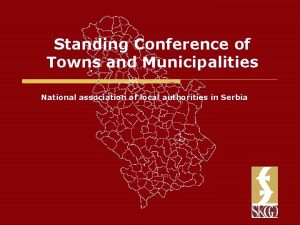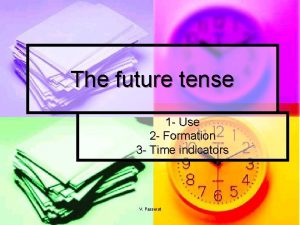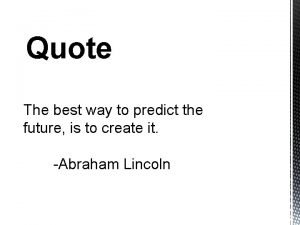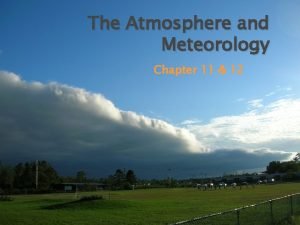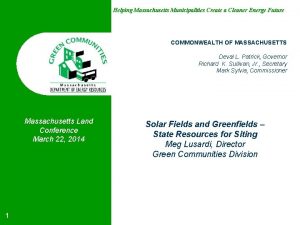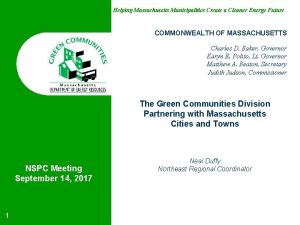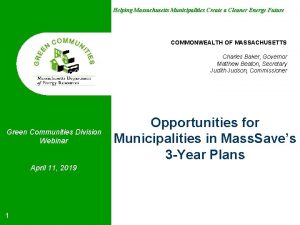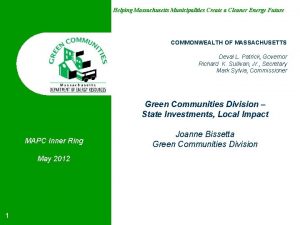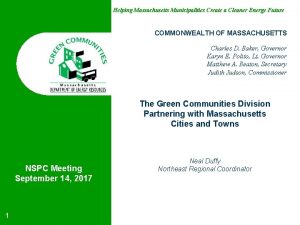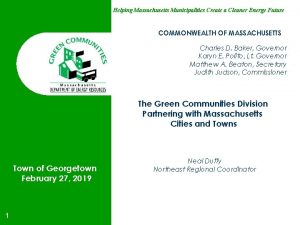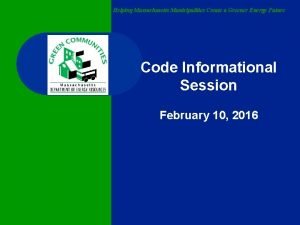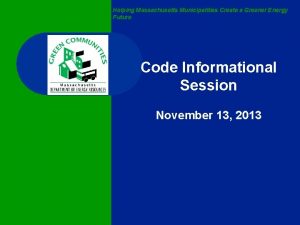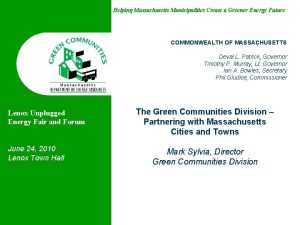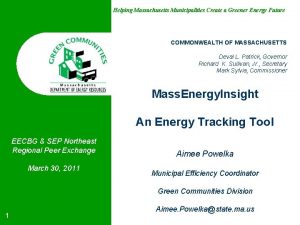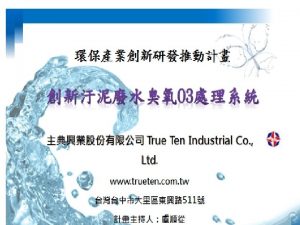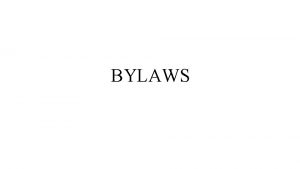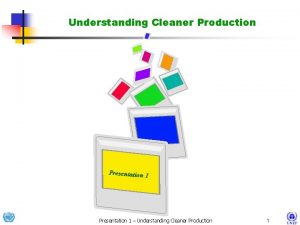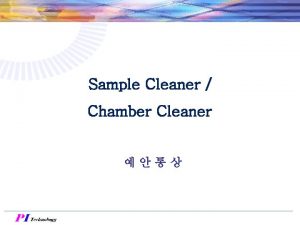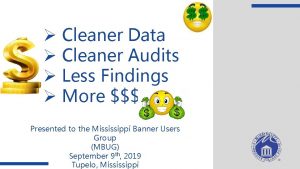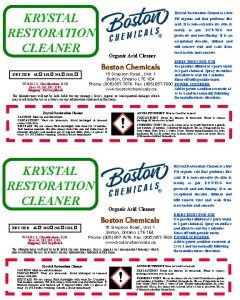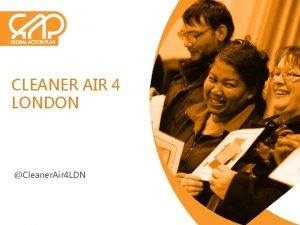Helping Massachusetts Municipalities Create a Cleaner Energy Future





















- Slides: 21

Helping Massachusetts Municipalities Create a Cleaner Energy Future COMMONWEALTH OF MASSACHUSETTS Charles D. Baker, Governor Karyn E. Polito, Lt. Governor Matthew A. Beaton, Secretary Judith Judson, Commissioner The Green Communities Division Partnering with Massachusetts Cities and Towns Town of North Attleboro Green Communities & Stretch Code Presentation 10/16/2019 1 Southeast Regional Coordinator

Green Communities Division The energy hub for all Massachusetts cities and towns, not just designated Green Communities. $ 2 Creating a Clean, Affordable and Resilient Energy Future for the Commonwealth

Green Communities Designation and Grant Program Up to $20 M/yr in grants and loans to qualifying communities Grants fund energy efficiency initiatives & renewable energy, innovative projects 3 Creating a Clean, Affordable and Resilient Energy Future for the Commonwealth

Designation and Grant Program >$105 M grants awarded >$10 M savings/yr 270 grants completed Projected Savings 316, 346 MMBTUs x 2, 822 4 28, 091 mt CO 2 eq. x 5, 914 Creating a Clean, Affordable and Resilient Energy Future for the Commonwealth

Designation and Grant Program Designation Grant = $125 K + population & per capita income formula North Attleboro’s estimated designation grant amount: $185, 000 -$190, 000 5 Competitive Grants available annually, up to $250, 000 per applicant, for existing Green Communities that have completed all prior grants Creating a Clean, Affordable and Resilient Energy Future for the Commonwealth

6 Creating a Clean, Affordable and Resilient Energy Future for the Commonwealth

Green Communities Designation and Grant Program Designation grant allocations based on a $125 K base plus a population/per capita income formula Competitive grants available annually up to $250, 000 per applicant for Green Communities. Projects being funded include energy conservation measures North Attleboro’s Green Communities Neighbors: 7 Community Year Grants Plainville 2017 $ 394, 025 Franklin 2017 $183, 020 Easton 2010 $ 745, 756 Dighton 2018 $ 143, 636 Seekonk 2018 $ 160, 790 Creating a Clean, Affordable and Resilient Energy Future for the Commonwealth

Designation and Grant Program Qualification Criteria - Designation 8 1. Adopt as-of-right siting for RE/AE generation, R&D, or manufacturing - 2. Adopt expedited permitting process 3. Create an Energy Reduction Plan to reduce energy use by 20% in 5 years 4. Adopt Fuel Efficient Vehicle Purchase Policy 5. Minimize life cycle cost in new construction adopt the Stretch Code Creating a Clean, Affordable and Resilient Energy Future for the Commonwealth

Green Communities Designation and Grant Flowchart Step 1 9 • Review Green Communities Designation Criteria Guidance • Contact your Green Communities Regional Coordinator Step 2 • Discuss Green Communities Designation with Local Government • Receive local approval to apply for Green Communities status Step 3 • Meet the 5 Green Communities Criteria and submit a Designation Application • Receive Green Community Designation from DOER • Apply for Green Community Grants Creating a Clean, Affordable and Resilient Energy Future for the Commonwealth

Criteria 5 – Minimize Life Cycle Costs Require all new residential construction and all new commercial and industrial real estate construction to minimize, to the extent feasible, the lifecycle cost of the facility by utilizing energy efficiency, water conservation and other renewable or alternative energy technologies. The DOER recommended way for cities and towns to meet this requirement is by adopting the BBRS Stretch Code (780 CMR 115. AA) an appendix to the MA State Building Code. • In North Attleboro, the Stretch Code must be adopted as a general bylaw by its Town Council. • https: //www. mass. gov/files/documents/2018/08/10/guidance-5 criterion. pdf 10 Creating a Clean, Affordable and Resilient Energy Future for the Commonwealth

Stretch Code Communities 11 Creating a Clean, Affordable and Resilient Energy Future for the Commonwealth

Stretch Code • The Stretch Code ONLY applies to: • NEW residential construction and • NEW commercial construction > 100, 000 sq. ft. or > 40, 000 sq. ft. for conditioned spaces = Labs & Supermarkets • Additions, Renovations & Repairs are EXEMPT from the Stretch Code 12 Creating a Clean, Affordable and Resilient Energy Future for the Commonwealth

The Stretch Code is No Longer Much of a Stretch • Base Energy Code (IECC 2015) and Stretch Code adopted by Massachusetts on 1/1/2017 • Current Base Code allows builders two options for residential and commercial new construction: 13 Prescriptive Performance • Checklist of Compliance Measures • Inspections During and Post Construction • • Pre & Post Construction Energy Modeling Inspections During and Post Construction Creating a Clean, Affordable and Resilient Energy Future for the Commonwealth

The Stretch Code is No Longer Much of a Stretch • Major differences between the Base & Stretch Code are: • Removal of the prescriptive path option • HERS Rater needs to provide an Energy Model. • The cost to perform the modelling required by the Stretch Code can be covered by utility incentive. Prescriptive • Checklist of compliance measures • Inspections during and post construction 14 Performance • • Pre & Post construction energy modeling Inspections during and post construction Creating a Clean, Affordable and Resilient Energy Future for the Commonwealth

Stretch Code old MIS-conceptions • ‘Stretch Code is new and experimental. ’ No; It is based on Energy Star for Home. • ‘Stretch Code requires tight unhealthy homes’ No; Building science has evolved • ‘Homes w/ oil heat can’t meet the Stretch Code’ No; It is easier to meet SC with gas, but. . . • ‘Town residents will be required to update their existing homes’ No; New Stretch Code only applies to NEW residential construction and explicitly exempts additions, renovation & repairs 15 Creating a Clean, Affordable and Resilient Energy Future for the Commonwealth

What does Stretch Code Apply to? Same application as the MA base energy code – Insulation – Doors, Windows, Skylights – Mechanical Equipment – Lighting – Appliances – Building tightness – Duct tightness – Renewables Not required but ‘points’ given Creating a Clean, Affordable and Resilient Energy Future for the Commonwealth

Why Test Performance? 17 Prescriptive codes don’t guarantee good installation, air and water tightness, or that thermal insulation is effective. Small air gaps can reduce insulation Rvalues by 50% or more. HERS Raters provide third party verification Creating a Clean, Affordable and Resilient Energy Future for the Commonwealth

What is the HERS Process? 1. Review Building Plans via Computer Energy Modeling 2. In-process inspections – First inspection • Duct tightness test (if applicable)* – Second Inspection (usually combined with 1 st) • Insulation – Final Inspection • Blower door test* 3. Finalize energy model based on verified performance and equipment *Required by Base Energy Code 2015 IECC 18 Creating a Clean, Affordable and Resilient Energy Future for the Commonwealth

What is the HERS Process? 1. Review Building Plans via Computer Energy Modeling 2. In-process inspections – First inspection • Duct tightness test (if applicable)* – Second Inspection (usually combined with 1 st) • Insulation – Final Inspection • Blower door test* 3. Finalize energy model based on verified performance and equipment *Required by Base Energy Code 2015 IECC 19 Creating a Clean, Affordable and Resilient Energy Future for the Commonwealth

What is a HERS Rating? (Home Energy Rating System) Annualized energy analysis Heating, Cooling, Water Heating, Lighting and Appliances…. On site power generation-renewable energy Reference Home Based on IECC 2006 Code (International Energy Conservation Code) Defined as 100 Points 1 percent change in consumption = 1 point HERS 55 means about 45% more efficient than reference home 20 Creating a Clean, Affordable and Resilient Energy Future for the Commonwealth

Green Communities Contacts Lisa Sullivan Lisa. M. Sullivan@mass. gov Website: http: //www. mass. gov/eea/energy-utilitiesclean-tech/green-communities/ 21 Creating a Clean, Affordable and Resilient Energy Future for the Commonwealth
 The 23 helping verbs
The 23 helping verbs South cotabato municipalities
South cotabato municipalities Standing conference of towns and municipalities
Standing conference of towns and municipalities Future continuous tense rules
Future continuous tense rules Future perfect simple continuous
Future perfect simple continuous List of helping verbs
List of helping verbs Structure of future tense
Structure of future tense 617-650-3557
617-650-3557 Apa itu mutiple queue dan one way list
Apa itu mutiple queue dan one way list The future is ours to create
The future is ours to create Lincoln the best way to predict the future is to create it
Lincoln the best way to predict the future is to create it Energy energy transfer and general energy analysis
Energy energy transfer and general energy analysis Energy energy transfer and general energy analysis
Energy energy transfer and general energy analysis Imbalances in earth’s heat energy help to create weather.
Imbalances in earth’s heat energy help to create weather. Future perfect presentation
Future perfect presentation Present and past tense
Present and past tense Future continuous.
Future continuous. Future nurse programme
Future nurse programme Present past and future continuous tense
Present past and future continuous tense Present continuous for future plan
Present continuous for future plan Future continuous and future perfect
Future continuous and future perfect Future plans and finished future actions
Future plans and finished future actions


